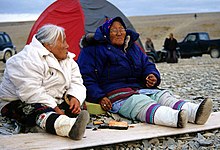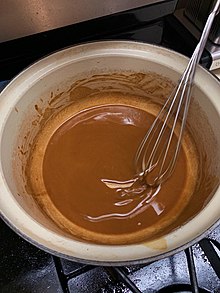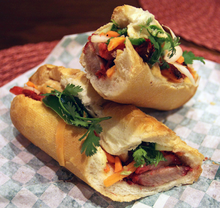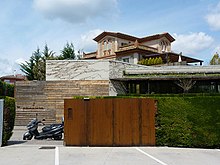Portal:Food
F o o d
A portal dedicated to food and foodways
Introduction


Food is any substance consumed by an organism for nutritional support. Food is usually of plant, animal, or fungal origin and contains essential nutrients such as carbohydrates, fats, proteins, vitamins, or minerals. The substance is ingested by an organism and assimilated by the organism's cells to provide energy, maintain life, or stimulate growth. Different species of animals have different feeding behaviours that satisfy the needs of their metabolisms and have evolved to fill a specific ecological niche within specific geographical contexts.
Omnivorous humans are highly adaptable and have adapted to obtain food in many different ecosystems. Humans generally use cooking to prepare food for consumption. The majority of the food energy required is supplied by the industrial food industry, which produces food through intensive agriculture and distributes it through complex food processing and food distribution systems. This system of conventional agriculture relies heavily on fossil fuels, which means that the food and agricultural systems are one of the major contributors to climate change, accounting for as much as 37% of total greenhouse gas emissions. (Full article...)
Cooking, also known as cookery or professionally as the culinary arts, is the art, science and craft of using heat to make food more palatable, digestible, nutritious, or safe. Cooking techniques and ingredients vary widely, from grilling food over an open fire, to using electric stoves, to baking in various types of ovens, reflecting local conditions. Cooking is an aspect of all human societies and a cultural universal.
Preparing food with heat or fire is an activity unique to humans. Archeological evidence of cooking fires from at least 300,000 years ago exists, but some estimate that humans started cooking up to 2 million years ago.
The expansion of agriculture, commerce, trade, and transportation between civilizations in different regions offered cooks many new ingredients. New inventions and technologies, such as the invention of pottery for holding and boiling of water, expanded cooking techniques. Some modern cooks apply advanced scientific techniques to food preparation to further enhance the flavor of the dish served. (Full article...)
El Celler de Can Roca is a restaurant in Girona, Catalonia, Spain opened in 1986 by the Roca brothers, Joan, Josep and Jordi. It was first located next to their parents' restaurant Can Roca, but moved to its current purpose-built building in 2007. It has been received warmly by critics, and holds three Michelin stars. El Celler de Can Roca was ranked the best restaurant in the world by the magazine Restaurant in 2013 and 2015, and was ranked second in 2011, 2012, 2014, and 2018. (Full article...)
Selected article –

Selected cuisine -

Historically Inuit cuisine, which is taken here to include Greenlandic cuisine, Yup'ik cuisine and Aleut cuisine, consisted of a diet of animal source foods that were fished, hunted, and gathered locally.
In the 20th century the Inuit diet began to change and by the 21st century the diet was closer to a Western diet. After hunting, they often honour the animals' spirit by singing songs and performing rituals. Although traditional or country foods still play an important role in the identity of Inuit, much food is purchased from the store, which has led to health problems and food insecurity. According to Edmund Searles in his article Food and the Making of Modern Inuit Identities, they consume this type of diet because a mostly meat diet is "effective in keeping the body warm, making the body strong, keeping the body fit, and even making that body healthy". (Full article...)Selected ingredient –

Roux (/ruː/) is a mixture of flour and fat cooked together and used to thicken sauces. Roux is typically made from equal parts of flour and fat by weight. The flour is added to the melted fat or oil on the stove top, blended until smooth, and cooked to the desired level of brownness. A roux can be white, blond (darker) or brown. Butter, bacon drippings or lard are commonly used fats. Roux is used as a thickening agent for gravy, sauces, soups and stews. It provides the base for a dish, and other ingredients are added after the roux is complete. (Full article...)
Selected recipe –

In Vietnamese cuisine, bánh mì or banh mi (/ˈbɑːn miː/, /ˈbæn/; Vietnamese: [ɓǎjŋ̟ mì], 'bread') is a short baguette with thin, crisp crust and a soft, airy texture. It is often split lengthwise and filled with meat and savory ingredients like a submarine sandwich and served as a meal, called bánh mì thịt. Plain bánh mì is also eaten as a staple food.
A typical Vietnamese roll or sandwich is a fusion of meats and vegetables from native Vietnamese cuisine such as chả lụa (Vietnamese sausage), coriander (cilantro), cucumber, pickled carrots, and pickled daikon combined with condiments from French cuisine such as pâté, along with red chili and mayonnaise. However, a variety of popular fillings are used, from xá xíu (Chinese barbecued pork) to even ice cream. In Vietnam, bread rolls and sandwiches are typically eaten for breakfast or as a snack. (Full article...)
Hannah Glasse (née Allgood; March 1708 – 1 September 1770) was an English cookery writer of the 18th century. Her first cookery book, The Art of Cookery Made Plain and Easy, published in 1747, became the best-selling recipe book that century. It was reprinted within its first year of publication, appeared in 20 editions in the 18th century, and continued to be published until well into the 19th century. She later wrote The Servants' Directory (1760) and The Compleat Confectioner, which was probably published in 1760; neither book was as commercially successful as her first.
Glasse was born in London to a Northumberland landowner and his mistress. After the relationship ended, Glasse was brought up in her father's family. When she was 16 she eloped with a 30-year-old Irish subaltern then on half-pay and lived in Essex, working on the estate of the Earls of Donegall. The couple struggled financially and, with the aim of raising money, Glasse wrote The Art of Cookery. She copied extensively from other cookery books, around a third of the recipes having been published elsewhere. Among her original recipes are the first known curry recipe written in English, as well as three recipes for pilau, an early reference to vanilla in English cuisine, the first recorded use of jelly in trifle, and an early recipe for ice cream. She was also the first to use the term "Yorkshire pudding" in print. (Full article...)Selected image –
Selected biography –
B. 28 October 1846 – d. 12 February 1935
Georges Auguste Escoffier (French: [ʒɔʁʒ oɡyst ɛskɔfje]; 28 October 1846 – 12 February 1935) was a French chef, restaurateur, and culinary writer who popularized and updated traditional French cooking methods. Much of Escoffier's technique was based on that of Marie-Antoine Carême, one of the codifiers of French haute cuisine; Escoffier's achievement was to simplify and modernize Carême's elaborate and ornate style. In particular, he codified the recipes for the five mother sauces. Referred to by the French press as roi des cuisiniers et cuisinier des rois ("king of chefs and chef of kings"—also previously said of Carême), Escoffier was a preeminent figure in London and Paris during the 1890s and the early part of the 20th century.
Alongside the recipes, Escoffier elevated the profession. In a time when kitchens were loud, riotous places where drinking on the job was commonplace, Escoffier demanded cleanliness, discipline, and silence from his staff. In bringing order to the kitchen, he tapped into his own military experience to develop the hierarchical brigade de cuisine system for organizing the kitchen staff which is still standard in many restaurants today. He worked in partnership with hotelier César Ritz, rising to prominence together at the Savoy in London serving the elite of society, and later at the Ritz Hotel in Paris and the Carlton in London. (Full article...)
Did you know (auto-generated) –

- ... that the fork-tailed drongo gives genuine alarm calls but will sometimes lie to steal food from other animals?
- ... that environmental activist Nigel Savage created Hazon after googling "Jewish food movement" and receiving zero search results?
- ... that food stylist Susan Spungen estimated that she baked hundreds of pies with Josh Brolin and film staff while practicing for a scene in Labor Day?
- ... that Cibo paints Italian food over neo-fascist graffiti?
- ... that in 1776 Abraham Hunt entertained Hessian mercenaries with food and drink to render them incapable for duty the night before George Washington defeated them at Trenton?
- ... that food psychology research has found that the COVID-19 pandemic led to both reduced and increased consumption of junk food among different geographical populations and educational backgrounds?
More did you know –
Related portals
Food topics
The following are topics relating to food
Categories
Food list articles
- See also: Lists of foods and Category:Lists of drinks
The following are some Food list articles on Wikipedia:

- American cheeses
- Appellation d'Origine Contrôlée cheeses
- Apple cultivars
- Bacon dishes
- Bacon substitutes
- Basil cultivars
- Breads
- Breakfast beverages
- Breakfast cereals
- Breakfast foods
- British cheeses
- Cakes
- Candies
- Cheeses
- Cheese soups
- Christmas dishes (list)
- Cocktails
- Cookies
- Dishes using coconut milk
- Diets
- Doughnut varieties
- Egg dishes
- Fermented soy products
- Food additives
- Food additives (Codex Alimentarius)
- Foods named after people
- French cheeses
- French dishes
- Fried dough foods
- Fruits
- List of hamburgers
- Herbs and spices
- Hors d'oeuvre
- Indian dishes
- Indian snack foods
- Indonesian dishes
- Italian dishes
- Japanese snacks
- Japanese dishes
- Jewish dishes
- Kebabs
- Korean beverages
- Mango cultivars
- Moroccan dishes
- Pasta
- Pastries
- Philippine snack food
- Pies, tarts and flans
- Poppy seed pastries and dishes
- Potato dishes
- Puddings
- Raw fish dishes
- Rice dishes
- Rolled foods
- Sauces
- Seafood
- Seeds
- Sandwiches
- Snack foods
- Soft drinks by country
- Soul foods and dishes
- Soups
- Stews
- Street foods
- Tapas
- Turkish dishes
- Twice-baked foods
- Vegetable oils
- Vegetables
- Vodkas
Things you can do
Related WikiProjects
| Parent project: WikiProject Food and Drink | |
| Child projects: | Task forces: (All inactive) |
|
|
| Related projects: | |
New articles
Rules | Match log | Results page (for watching) | Last updated: 2024-05-01 19:18 (UTC)
Note: The list display can now be customized by each user. See List display personalization for details.
- Museum of Toruń Gingerbread (edit | talk | history | links | watch | logs | tools) by Dnaoro (talk · contribs · new pages (3)) started on 2024-05-01, score: 20
- Murau Brewery (edit | talk | history | links | watch | logs | tools) by 0Lucky Luke (talk · contribs · new pages (1)) started on 2024-05-01, score: 10
- Esther Choi (edit | talk | history | links | watch | logs | tools) by MemeDab99 (talk · contribs · new pages (5)) started on 2024-04-30, score: 10
- Greens powder (edit | talk | history | links | watch | logs | tools) by Psywave (talk · contribs · new pages (1)) started on 2024-04-30, score: 10
- Koffi (restaurant) (edit | talk | history | links | watch | logs | tools) by Another Believer (talk · contribs · new pages (146)) started on 2024-04-30, score: 10
- H. Avard Loomer (edit | talk | history | links | watch | logs | tools) by B3251 (talk · contribs · new pages (28)) started on 2024-04-30, score: 10
- Sherman's Deli & Bakery (edit | talk | history | links | watch | logs | tools) by Another Believer (talk · contribs · new pages (146)) started on 2024-04-30, score: 10
- Paul B. Wishart (edit | talk | history | links | watch | logs | tools) by Dmarsch (talk · contribs · new pages (5)) started on 2024-04-29, score: 10
- Meat water holding capacity (edit | talk | history | links | watch | logs | tools) by GobsPint (talk · contribs · new pages (131)) started on 2024-04-29, score: 10
- Meat diaper (edit | talk | history | links | watch | logs | tools) by GobsPint (talk · contribs · new pages (131)) started on 2024-04-29, score: 20
- Localis (restaurant) (edit | talk | history | links | watch | logs | tools) by Another Believer (talk · contribs · new pages (146)) started on 2024-04-29, score: 10
- Waxi's (edit | talk | history | links | watch | logs | tools) by Jacobo Marcus Galicia (talk · contribs · new pages (1)) started on 2024-04-25, score: 10
- Westman's Bagel & Coffee (edit | talk | history | links | watch | logs | tools) by Another Believer (talk · contribs · new pages (146)) started on 2024-04-19, score: 10
- Kōki Saitō (edit | talk | history | links | watch | logs | tools) by Cynikles (talk · contribs · new pages (1)) started on 2024-04-29, score: 10
- 24 in 24: Last Chef Standing (edit | talk | history | links | watch | logs | tools) by TristanQuinn (talk · contribs · new pages (2)) started on 2024-04-29, score: 10
- La Mejor Bakery (edit | talk | history | links | watch | logs | tools) by BaduFerreira (talk · contribs · new pages (12)) started on 2024-04-29, score: 20
- Wilson Davis (edit | talk | history | links | watch | logs | tools) by Vycl1994 (talk · contribs · new pages (18)) started on 2024-04-28, score: 10
- Sweet Rose Creamery (edit | talk | history | links | watch | logs | tools) by TrademarkedTWOrantula (talk · contribs · new pages (5)) started on 2024-04-28, score: 10
- Hunters Palm Springs (edit | talk | history | links | watch | logs | tools) by Another Believer (talk · contribs · new pages (146)) started on 2024-04-28, score: 10
- Haitian spaghetti (edit | talk | history | links | watch | logs | tools) by Valereee (talk · contribs · new pages (8)) started on 2024-04-27, score: 10
- Artocarpus styracifolius (edit | talk | history | links | watch | logs | tools) by Ulathijau (talk · contribs · new pages (2)) started on 2024-04-27, score: 10
- Atomo (edit | talk | history | links | watch | logs | tools) by White 720 (talk · contribs · new pages (2)) started on 2024-04-27, score: 30
- Lauren Rudolph E. coli case (edit | talk | history | links | watch | logs | tools) by Margaretdonnelly (talk · contribs · new pages (1)) started on 2024-04-23, score: 10
- Ruditapes philippinarum (edit | talk | history | links | watch | logs | tools) by Sjl197 (talk · contribs · new pages (1)) started on 2024-04-27, score: 10
- Bonèt (edit | talk | history | links | watch | logs | tools) by Frankserafini87 (talk · contribs · new pages (3)) started on 2024-04-26, score: 20
- Ganmianpi (edit | talk | history | links | watch | logs | tools) by Iuliusnanus (talk · contribs · new pages (8)) started on 2024-04-25, score: 10
- D'Ambrosio Gelato (edit | talk | history | links | watch | logs | tools) by Another Believer (talk · contribs · new pages (146)) started on 2024-04-25, score: 10
- Murcian meat pie (edit | talk | history | links | watch | logs | tools) by ChampClancy (talk · contribs · new pages (1)) started on 2024-04-24, score: 20
- Full Tilt Ice Cream (edit | talk | history | links | watch | logs | tools) by Another Believer (talk · contribs · new pages (146)) started on 2024-04-24, score: 10
- Roger Hugo (edit | talk | history | links | watch | logs | tools) by NouveauSarfas (talk · contribs · new pages (1)) started on 2024-04-24, score: 10
- Gelatiamo (edit | talk | history | links | watch | logs | tools) by Another Believer (talk · contribs · new pages (146)) started on 2024-04-24, score: 10
- Paratrophis banksii (edit | talk | history | links | watch | logs | tools) by Tom Radulovich (talk · contribs · new pages (159)) started on 2024-04-23, score: 10
- Dumb bread (edit | talk | history | links | watch | logs | tools) by LittleT889 (talk · contribs · new pages (10)) started on 2024-04-23, score: 10
- Frankie & Jo's (edit | talk | history | links | watch | logs | tools) by Another Believer (talk · contribs · new pages (146)) started on 2024-04-23, score: 10
- List of food and drink monuments (edit | talk | history | links | watch | logs | tools) by Altenmann (talk · contribs · new pages (75)) started on 2024-04-23, score: 20
- Ko Omm (edit | talk | history | links | watch | logs | tools) by Sattwaikyaw (talk · contribs · new pages (1)) started on 2024-04-22, score: 10
- Rachel's Ginger Beer (edit | talk | history | links | watch | logs | tools) by Another Believer (talk · contribs · new pages (146)) started on 2024-04-22, score: 10
- Crisp pork (edit | talk | history | links | watch | logs | tools) by チャリス (talk · contribs · new pages (8)) started on 2024-04-22, score: 20
- "Flower" tofu (edit | talk | history | links | watch | logs | tools) by チャリス (talk · contribs · new pages (8)) started on 2024-04-22, score: 10
- Taro pastry (edit | talk | history | links | watch | logs | tools) by Heeheemalu (talk · contribs · new pages (14)) started on 2024-04-22, score: 10
- Garbage Plate (edit | talk | history | links | watch | logs | tools) by BanjoZebra (talk · contribs · new pages (6)) started on 2024-04-10, score: 40
- Morning in America (EP) (edit | talk | history | links | watch | logs | tools) by OttoJohn (talk · contribs · new pages (1)) started on 2024-04-21, score: 10
- Mike's Hot Honey (edit | talk | history | links | watch | logs | tools) by BanjoZebra (talk · contribs · new pages (6)) started on 2024-04-21, score: 40
- Zajiangmian (edit | talk | history | links | watch | logs | tools) by チャリス (talk · contribs · new pages (8)) started on 2024-04-21, score: 20
- Cannabis in the restaurant industry (edit | talk | history | links | watch | logs | tools) by Another Believer (talk · contribs · new pages (146)) started on 2024-04-21, score: 10
- Kentrell Barkley (edit | talk | history | links | watch | logs | tools) by Skyggestadium (talk · contribs · new pages (7)) started on 2024-04-21, score: 10
- Coffee Talk Episode 2: Hibiscus & Butterfly (edit | talk | history | links | watch | logs | tools) by JuniperChill (talk · contribs · new pages (12)) started on 2024-04-20, score: 20
- Dough Joy (edit | talk | history | links | watch | logs | tools) by Another Believer (talk · contribs · new pages (146)) started on 2024-04-20, score: 20
- Chicken galantina (edit | talk | history | links | watch | logs | tools) by Obsidian Soul (talk · contribs · new pages (37)) started on 2024-04-19, score: 20
- Ponche Navideño (edit | talk | history | links | watch | logs | tools) by Valereee (talk · contribs · new pages (8)) started on 2024-04-19, score: 20
- Lengua estofado (edit | talk | history | links | watch | logs | tools) by Obsidian Soul (talk · contribs · new pages (37)) started on 2024-04-19, score: 20
- PDX671 (edit | talk | history | links | watch | logs | tools) by Another Believer (talk · contribs · new pages (146)) started on 2024-04-19, score: 10
- Taqua banana (edit | talk | history | links | watch | logs | tools) by Fredo.fernando (talk · contribs · new pages (1)) started on 2024-04-18, score: 10
- Butifarra (sandwich) (edit | talk | history | links | watch | logs | tools) by Tony24644 (talk · contribs · new pages (6)) started on 2024-04-18, score: 10
- Kuai Kuai (edit | talk | history | links | watch | logs | tools) by Heeheemalu (talk · contribs · new pages (14)) started on 2024-04-17, score: 20
- Rocklands Barbeque and Grilling Company (edit | talk | history | links | watch | logs | tools) by DarkNight0917 (talk · contribs · new pages (7)) started on 2024-04-17, score: 10
- Sweet Alchemy (edit | talk | history | links | watch | logs | tools) by Another Believer (talk · contribs · new pages (146)) started on 2024-04-16, score: 10
- The Lakes Distillery (edit | talk | history | links | watch | logs | tools) by ChefBear01 (talk · contribs · new pages (4)) started on 2024-04-16, score: 20
Associated Wikimedia
The following Wikimedia Foundation sister projects provide more on this subject:
-
Commons
Free media repository -
Wikibooks
Free textbooks and manuals -
Wikidata
Free knowledge base -
Wikinews
Free-content news -
Wikiquote
Collection of quotations -
Wikisource
Free-content library -
Wikiversity
Free learning tools -
Wiktionary
Dictionary and thesaurus















































